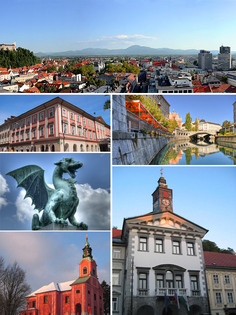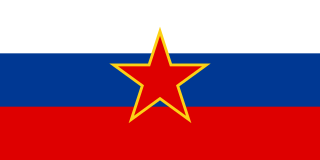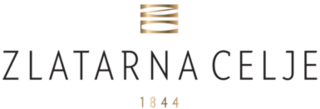
Slovenia, officially the Republic of Slovenia, is a sovereign state located in southern Central Europe at a crossroads of important European cultural and trade routes. It is bordered by Italy to the west, Austria to the north, Hungary to the northeast, Croatia to the southeast, and the Adriatic Sea to the southwest. It covers 20,273 square kilometers (7,827 sq mi) and has a population of 2.07 million. One of the successor states of the former Yugoslavia, Slovenia is a parliamentary republic and a member of the United Nations, of the European Union, and of NATO. The capital and largest city is Ljubljana.

The Slovenian Armed Forces or Slovenian Army are the armed forces of Slovenia. Since 2003, it is organized as a fully professional standing army. The Commander-in-Chief of the SAF is the President of the Republic of Slovenia, while operational command is in the domain of the Chief of the General Staff of the Slovenian Armed Forces.

Slovene or Slovenian belongs to the group of South Slavic languages. It is spoken by approximately 2.5 million speakers worldwide, the majority of whom live in Slovenia. It is the first language of about 2.1 million Slovenian people and is one of the 24 official and working languages of the European Union.

Ljubljana is the capital and largest city of Slovenia. It has been the cultural, educational, economic, political, and administrative centre of independent Slovenia since 1991.

The Slovenes, also known as Slovenians, are a nation and South Slavic ethnic group native to Slovenia, and also to Italy, Austria and Hungary in addition to having a diaspora throughout the world. Slovenes share a common ancestry, culture, history and speak Slovene as their native language.

Nogometni klub Maribor, commonly referred to as NK Maribor or simply Maribor, is a professional football club based in Maribor, Slovenia, that competes in the Slovenian PrvaLiga, the top tier of Slovenian football. Nicknamed "The Purples", the club was founded on 12 December 1960. They are regarded as a symbol of Slovenian football, particularly in their home region of Styria in northeastern Slovenia.

The Slovenia national football team represents Slovenia in international football and is controlled by the Football Association of Slovenia. In the period between 1920 and 1991, Slovenia was ineligible to field a separate team for competitive matches; local players instead played for the Yugoslavia national football team. Slovenia played its first official match in 1992, one year after the country gained independence from Yugoslavia.

The Football Association of Slovenia is the governing body of football in Slovenia. It organizes the first division, second division, third division, Slovenian Cup, Slovenian Women's League, and other competitions. It is also responsible for the Slovenia national football team and the Slovenia women's national football team. It was founded as Ljubljana Football Subassociation on 23 April 1920.

Nogometni klub Olimpija Ljubljana, commonly referred to as Olimpija Ljubljana or simply Olimpija, is a professional association football club, based in the city of Ljubljana, Slovenia. The club competes in the Slovenian PrvaLiga, the country's highest football division.

The Ten-Day War, or the Slovenian Independence War, was a brief conflict that followed the Slovenian declaration of independence on 25 June 1991. It was fought between the Slovenian Territorial Defence and the Yugoslav People's Army (JNA). It lasted from 27 June 1991 until 7 July 1991, when the Brioni Accords were signed. It marked the beginning of the Yugoslav Wars.

The Slovenian First Football League, currently named Prva liga Telekom Slovenije[ˈpərʋa ˈliːɡa ˈteːlɛkɔm slɔˈʋeːnijɛ] due to sponsorship reasons, also known by the abbreviation 1. SNL, is the main football league in Slovenia, and was formed in 1991 after Slovenia became an independent country. From 1920 until the end of the 1990–91 season, the Slovenian Republic League was a lower division of the Yugoslavian league football system. The league is currently governed by the Football Association of Slovenia. Between 2001 and 2012 the league was governed by the Association of 1. SNL. Celje, Gorica and Maribor are the only three clubs that have never been relegated from the league since its foundation in 1991.

Slovenia has been a meeting area of the Slavic, Germanic, Romance, and Uralic linguistic and cultural regions, which makes it the most complex meeting point of languages in Europe. The official and national language of Slovenia is Slovene, which is spoken by a large majority of the population. It is also known, in English, as Slovenian. Two minority languages, namely Hungarian and Italian, are recognised as co-official languages and accordingly protected in their residential municipalities. Other significant languages are Croatian and its variants and Serbian, spoken by most immigrants from former Yugoslavia and their descendants. Slovenia is ranked among the top European countries regarding the knowledge of foreign languages. The most often taught foreign languages are English and German, followed by Italian, French, and Spanish.

The Socialist Republic of Slovenia was one of the six republics forming the post-World War II country of Yugoslavia. It existed under different names from 29 November 1945 until 25 June 1991. In 1990, while the country was still a part of the Yugoslav federation, the League of Communists of Slovenia allowed for the establishment of other political parties, which led to the democratization of the country. The official name of the republic was Federal Slovenia until 20 February 1946, when it was renamed the People's Republic of Slovenia. It retained this name until 9 April 1963, when its name was changed again, this time to Socialist Republic of Slovenia. On 8 March 1990, the Socialist Republic of Slovenia removed the prefix "Socialist" from its name, becoming the Republic of Slovenia, though remaining a constituent state of the Socialist Federal Republic of Yugoslavia until 25 June 1991, when it enacted the laws resulting in independence.

Gaberje is a district of the City Municipality of Celje and a neighbourhood of the town of Celje in central-eastern Slovenia. It is particularly known as a workers' settlement.
Gaberje is a Slovene place name that may refer to:

Gabrje is a settlement north of Dobrova in the Municipality of Dobrova–Polhov Gradec in the Upper Carniola region of Slovenia. It also comprises the hamlets of Jarčji Potok, Knapovec, Pod Kotom, Ravnik, and Žerovnik. The settlement includes three creeks—from west to east, Žerovnik Creek, Jarc Creek, and Ostrožnik Creek—all tributaries of the Gradaščica River.

Gaberje is a village in the hills south of the Vipava Valley in the Municipality of Ajdovščina in the Littoral region of Slovenia. It was first mentioned in written documents dating to 1367.

The statistical regions of Slovenia are 12 administrative entities created in 2000 for legal and statistical purposes.

Zlatarna Celje, PLC, is a Slovenian jeweler and goldsmith located in Celje. About 70% of its business is from the sale of jewelry and gold bullion, and the company also manufactures dental alloys and industrial gold. Zlatarna Celje's retail stores are mainly located in Slovenia and the countries of the former Yugoslavia. Today, the company markets its products under the Zlatarna Celje and Lencia brand names, the latter of which has developed a collection line with Tina Maze, a Slovenian skier. It has also invested in the construction of the Plaza hotel BTC City (Ljubljana).





















